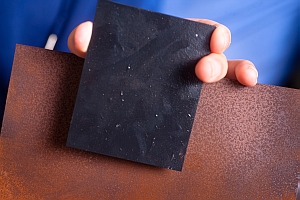
Steel coated with a graphene compound, in foreground, remains rust-free, while and the uncoated steel in the background accumulates rust. (University at Buffalo)
Chemistry researchers from University at Buffalo in New York are developing a process for rust-proofing steel using a graphene-based composite as a coating. The Indian steel manufacturer Tata Steel is participating in the research by chemistry professor Sarbajit Banerjee and doctoral candidate Robert Dennis.
In early experiments, Banerjee and Dennis were able to increase the amount of time pieces of steel coated with a graphene varnish remained rust-free from a few days to about a month, when the steel was left immersed in a harsh, salty brine solution. The chemists were able to achieve the longer rust-proofing duration by adjusting the concentration and dispersion of graphene in the varnish. The briny test solution is considered far more damaging to steel than day-to-day exposure to the environment.
Graphene is a material configured as a layer of carbon atoms arranged in a hexagonal lattice, with unusual qualities of strength and conductivity which make it a versatile ingredient for a range of electronics, communications, and industrial products. The material’s water-repellant and conductive properties may help prevent corrosion and slow the oxidation of steel known as rust.
A new form of steel coating would meet an industry need for a non-toxic alternative to coatings used with stainless steel and chrome plating that contain hexavalent chromium. The Occupational Safety and Health Administration says workers who breathe hexavalent chromium compounds at their jobs for many years may be at increased risk of developing lung cancer. Breathing high levels of hexavalent chromium can irritate or damage the nose, throat, lungs, eyes, and skin, particularly in high concentrations or for a prolonged period of time.
Banerjee and Dennis will next aim to enhance the graphene composite’s lasting power, as well as the quality of its finish, supported by a $50,000 grant from the New York State Pollution Prevention Institute. Tata Steel has helped the project with testing of various sizes of sample pieces.
Buffalo’s technology transfer office has filed a provisional patent for the coating. The university says Tata Steel also has some rights to the technology.
In the following video Dennis — a native of Western New York — tells how the project dovetails with Buffalo’s history as a center for steel manufacturing.
- Modified Graphene Found to Dissipate Electronics Heat
- Graphene-Based Material Developed with Teflon Properties
* * *

 RSS - Posts
RSS - Posts
That’s cool, I don’t see why they can’t just coat any metal in some kind of really strong silicone or something that will stop any oxygen combining with the iron. Or perhaps just a coating that stops the loss of electrons… Why does metal loose electrons in the first place?
Thank you for your note and visiting Science Business. My apologies for the delayed response, but I was traveling in an area without Internet access for a week. That’s a good question. My guess is that they wanted a way of taking advantage of the electronic and thermal conductivity of graphene without altering the composition of the underlying steel. – AK